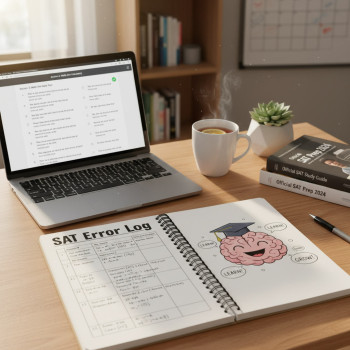Why a Weekly “Power Hour” Beats Random Studying
Let’s be honest: studying in long, unstructured bursts or scrolling past SAT posts between classes rarely moves the needle. Quality matters more than quantity — which is exactly why a weekly “Power Hour” can be a game-changer. One focused, well-planned hour each week beats three distracted hours. That hour creates a reliable anchor in your week: a small, repeatable habit that compounds into big score gains.
What a Power Hour Does for You
- Builds momentum through consistency — one hour becomes many over a semester.
- Helps you identify weaknesses quickly and target them with intention.
- Teaches time management under real test conditions (digital timing and navigation).
- Reduces anxiety by replacing vague goals with concrete tasks.
How to Structure Your Power Hour: A Simple, Repeatable Template
The best Power Hour feels purposeful but flexible. Use the following template the first few times, then tweak it based on what’s working for you.
60-Minute Power Hour Template
- 0–5 minutes: Warm-up & focus ritual — clear distractions, breathe, open your test app or materials, and set a tiny goal for the hour.
- 5–25 minutes: Targeted practice — work on a single skill area (e.g., grid-in math, evidence-based reading passages, command of evidence questions).
- 25–40 minutes: Timed mini-section — do a short, timed set of questions that mimics Digital SAT pacing.
- 40–50 minutes: Rapid review — check answers, note patterns, write 2–3 key takeaways.
- 50–60 minutes: Reflection & next steps — log what you learned, schedule one follow-up micro-task before the next Power Hour.
The trick is to treat the hour like a laboratory session: try something specific, measure the result, and leave with an experiment for next time.
Choosing the Right Focus Each Week
Rotate the emphasis so you don’t burn out one area and ignore others. A simple rotating plan might look like this:
- Week 1: Reading (evidence-based reading strategies)
- Week 2: Writing & Language (grammar patterns & editing)
- Week 3: Math (calculator and no-calculator skills)
- Week 4: Practice test simulation + review
How to Pick the Specific Skill
Use your previous mistakes. If you don’t have practice-test data yet, start with common weak spots: algebra fundamentals, multistep word problems, inference questions in reading, or subject-verb agreement in writing. If you use adaptive report tools or practice dashboards, let those guide you — they point to the highest-impact gaps.
Example Weekly Power Hour Plans
Below are three sample Power Hours tailored for different stages of prep: early (building basics), mid (sharpening timing), and late (polish & strategy).
Power Hour — Early Prep (Foundations)
- 0–5: Mental warm-up and review of last week’s takeaways.
- 5–25: Focused lessons on a core skill (e.g., linear equations for math; finding main ideas for reading).
- 25–40: Practice 10 targeted questions, untimed at first for accuracy.
- 40–50: Review and create 3 flashcard prompts for the weak points.
- 50–60: Plan a small midweek 10-minute drill to reinforce one flashcard.
Power Hour — Mid Prep (Pacing & Strategy)
- 0–5: Quick breathing exercise and a one-sentence goal: “Finish this mini-section with +80% accuracy.”
- 5–25: Timed practice set (15–18 minutes), mirroring digital test layout.
- 25–35: Immediate check and error analysis.
- 35–50: Strategy work — learn a timing trick (e.g., triage passages, math problem triage) and apply to 3 practice items.
- 50–60: Log progress and note one timing behavior to change next week.
Power Hour — Late Prep (Polish & Confidence)
- 0–5: Review target score and remind yourself of progress.
- 5–35: Full timed section (reading or writing) under testlike conditions.
- 35–50: Detailed error analysis: categorize mistakes into careless, conceptual, timing, or misread.
- 50–60: Micro-plan for test week: checklist items like device check, sleep schedule, and quick review topics.
Tools & Resources to Make Your Hour Authentic and Effective
Because the SAT is digital, simulate that environment. Use official practice sets, the Bluebook practice app if available, or any test environment that mimics the digital layout and timing. Below are types of resources that fit into a Power Hour.
- Official practice questions (for authenticity)
- Timed mini-sections from practice banks
- Khan-style personalized practice for skill building
- Flashcards and quick drills for memory recall
- One-on-one review sessions when you get stuck
If you’re seeking structured, personalized help, consider adding brief, targeted tutoring check-ins to your routine. Sparkl’s personalized tutoring can slot in as a monthly or biweekly check-up to review your Power Hour results, refine your study plan, and provide AI-driven insights to accelerate progress.
Tracking Progress: A Simple Table to Measure Gains
Tracking makes your Power Hour accountable. Use this compact table each week to record one section’s mini-score and a short note about what improved.
| Week | Focus | Mini-section Score (out of 100) | Top 2 Takeaways |
|---|---|---|---|
| 1 | Reading – Main idea | 78 | Slow down on first paragraph; highlight transitions |
| 2 | Math – Linear equations | 85 | Set up equations first; check units |
| 3 | Writing – Punctuation | 92 | Comma rules review helped; fewer careless errors |
How to Use the Table
Keep a running digital or paper log. After 6–8 weeks you’ll see trends: which skills grow steadily, which stall, and which weeks had the biggest jumps (often after a targeted mini-lesson or quick tutoring check-in).
Micro-Habits That Boost Your Power Hour
The hour is the anchor, but micro-habits between Power Hours create the lift. Here are small, high-return habits to sprinkle through your week.
- 10-minute daily vocabulary or grammar flashcards.
- Two-question daily math drill on your phone or in a notebook.
- One-paragraph summary of a short article to sharpen reading comprehension.
- Recording one mistake and the correction in a tiny notebook — this builds a personal error bank.
Why Micro-Habits Matter
These tiny practices keep neural pathways warm so your weekly Power Hour can work on skill-level improvements rather than reteaching basics.
Common Pitfalls and How to Avoid Them
Students often sabotage their Power Hour without realizing it. Here are common mistakes and quick fixes.
- Pitfall: Starting without a clear goal. Fix: Begin with one sentence describing what success looks like this hour.
- Pitfall: Practicing too broadly. Fix: Focus on one skill and one timed set per hour.
- Pitfall: Skipping review. Fix: Always spend at least 10 minutes analyzing errors — that’s where the learning happens.
- Pitfall: Ignoring test conditions (digital navigation/timing). Fix: Simulate digital test software at least twice a month so there are no surprises on test day.
When to Bring in Help: Tutoring, Coaches, and Check-Ins
If your weekly Power Hour has plateaued, bring in a short-cycle expert review. An outside perspective is especially valuable when:
- Your error patterns repeat and you can’t diagnose the root cause.
- Your score improvements stall despite steady effort.
- You want to compress learning time before a registration deadline.
One-on-one tutoring sessions can be scheduled around your Power Hour: use the hour to prepare and the tutoring session to debrief and retool. Sparkl’s personalized tutoring model — with tailored study plans, expert tutors, and AI-driven insights — fits naturally into this rhythm by translating your Power Hour logs into focused lessons and quick adjustments.
Practical Examples: Two Student Stories
Case Study: Maya — From 640 to 720 in Three Months
Maya started with three scattered study sessions a week and little tracking. After adopting a Monday evening Power Hour, focusing alternately on reading and math, and logging mini-scores, she noticed recurring errors on data interpretation questions in math. She added two 10-minute midweek drills, addressed misconceptions in a short tutoring call, and started scoring consistently higher on mini-sections. The steady habit and targeted correction produced a jump of 80 points in three months.
Case Study: Jamal — Beating Time Pressure
Jamal was accurate but slow. He used Power Hours to practice pacing: timed mini-sections followed by a 10-minute analysis of time spent per question. He learned to triage — which questions to attack, which to flag — and practiced skipping strategically. By the time he took a full practice test, his accuracy remained high while his timing improved by nearly 20% on timed sets.
How to Make Your Power Hour Feel Sustainable (So It Doesn’t Burn You Out)
Sustainability is about habit design. Make the hour feel easy to start and rewarding to finish.
- Pick a consistent day and time (e.g., Sunday 5:00–6:00 pm). Rituals help: same spot, same playlist, same notebook.
- Keep the first 5 minutes enjoyable — a short ritual to settle in, not a reminder of work.
- End with a visible win — a mini-note, a correct problem, or a small sticker on your calendar.
- Every 4 weeks, reward yourself with a bigger treat for sticking to the routine (movie night, a hike, or a meal out).
Sample 8-Week Power Hour Plan (Overview)
This plan assumes one Power Hour per week plus micro-habits during the week.
| Week | Main Focus | Micro-Habit During Week |
|---|---|---|
| 1 | Reading – main idea and paragraph purpose | Daily 5-minute article summary |
| 2 | Math – linear equations and function basics | Two 2-question equation drills midweek |
| 3 | Writing – sentence structure and concision | Daily 10 grammar flashcards |
| 4 | Timed practice – reading section | One short timed reading set midweek |
| 5 | Math – ratios, proportions, and data interpretation | Graph reading drill twice during week |
| 6 | Writing – punctuation and transitions | Edit a paragraph each day |
| 7 | Full timed section practice (choose weakest) | Quick error log review every other day |
| 8 | Review & test-like simulation | Sleep and test-week checklist |
Image Ideas to Make Your Power Hour Visual
Visuals help your brain map a routine. Place these images in your study space, digital planner, or phone wallpaper to cue the habit.
Final Checklist: Getting the Most from Every Power Hour
- Decide the day and time, and block it in your calendar as non-negotiable.
- Pick a single skill focus and one timed mini-section each session.
- Do quick, disciplined error analysis — your mistakes are the map to improvement.
- Keep a small set of micro-habits that maintain momentum between hours.
- Use short tutoring check-ins when you need to decode persistent problems. A personalized tutor (like those available at Sparkl) can translate your Power Hour logs into razor-sharp next steps.
- Celebrate small wins — they keep you consistent.
Parting Thought: Make the Hour Yours
Building a Power Hour is both simple and creative. The structure matters, but the best plan is the one you actually follow. Start small, iterate weekly, and use honest data (your mini-scores and error logs) to steer the plan. Over time, that weekly hour becomes not just practice, but proof: proof that deliberate, focused work adds up to real improvement on the Digital SAT. Put on your timer, pick a single target, and watch the compounding begin.
Ready to try your first Power Hour? Pick a day this week, write down one goal, and commit. If you want guided feedback after your first three Power Hours, a short personalized session with an expert tutor can help you translate early patterns into a tailored study path that fits your life and goals.














No Comments
Leave a comment Cancel